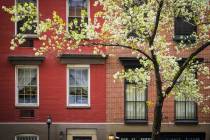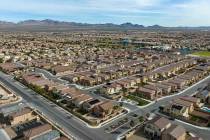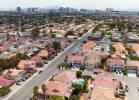Real estate exodus in LV?
A few years ago, it seemed as if everyone knew someone in Las Vegas who was getting their real estate license and cashing in on the housing boom.
It was a time when all an agent had to do was stick a "For Sale" sign in the front yard and wait for offers to roll in.
Membership in the Greater Las Vegas Association of Realtors grew from 7,959 in January 2003 to 16,379 in January 2007, gaining 1,700 to 2,500 members a year. Statewide, the number of licensed real estate agents jumped from 17,718 in 2000 to 36,785 in 2006.
Now that home sales have dropped by 26 percent and buyers have gone into retreat waiting for the market to bottom out, Realtors are working harder to earn their commissions. They're having to pick up the phone for "cold calls," knock on doors and spend more money on marketing.
Some are finding new careers or taking second jobs.
Kurt Lehman of Realty One Group worked various jobs over the past year to make ends meet, including account representative for a commercial cleaning service, home-improvement sales and consultant for incorporating in Nevada.
Lehman, who became a Realtor in May 2001, recently made his first sale in several months with a home that was listed for $499,000 in the Canyon Ridge subdivision of Peccole Ranch.
The home sat on the market for seven months even though prospective buyers were taking 40 to 50 fliers, featuring color pictures of the house, a week. The fliers cost about 50 cents each.
That cost was in addition to the $400 Lehman pays for annual membership in the Realtors association and $270 every six months for Multiple Listing Services access fee.
"The real challenge of staying in business," he said, "is if you're paying money and not making money, how do you generate new business?"
Of the nearly 37,000 licensed real estate agents in Nevada, 21 percent were inactive as of October, Las Vegas-based Applied Analysis revealed in the Nevada Association of Realtors 2006 State of the Industry Report.
Tony Silva, broker manager at Realty One, said a few of his 238 agents have left for other jobs, but he keeps their licenses hanging in his office while most of them work on real estate from their homes.
"You have to understand the market. There's going to be tough times," Silva said. "They need to pay their bills, but we're encouraging agents not to lose their license. They worked too hard for it. Get another job and team up with someone in the office to watch each other's business while the other one works."
Greater Las Vegas Association of Realtors officials said they don't have any names of people they know to be leaving the profession or turning to part-time work.
Although the number of inactive licenses could suggest that a structural unemployment shift is afoot, Jeremy Aguero, principal of Las Vegas financial consulting firm Applied Analysis, noted that the share of inactive agents was nearly 32 percent in 1996, 29 percent in 2000 and 20 percent in 2004.
Instead of focusing on inactive licenses, Aguero suggests observers look at the number of agents in relation to overall population. That figure stood at 19.8 licensed real estate agents in Nevada per 1,000 population in October, the highest rate on record, the Nevada Division of Real Estate reports.
That's 32.9 percent higher than the 14.9 licensed agents per 1,000 population in 1996 and 55.9 percent higher than the 12.7 figure in 2000.
"Regardless of (home) price escalations or declines, it is highly unlikely that the volume of transactions reported between 2003 and 2005 will be repeated during the next 24 months," Aguero said, "and it will be difficult if not impossible to sustain this level of employment."
Nevada's real estate sales and brokerage businesses directly employ more than 48,000 people, more than double the number in 1997, and generate nearly $2 billion in personal income each year, the report said. The secondary effects of the industry's employment support an estimated 95,670 positions and $3.4 billion in annual personal income.
Real estate professionals and their direct employees generate an estimated $138.3 million annually in major state and local revenues, including $50.4 million in retail sales and use taxes and $83.4 million in property taxes.
These figures do not include real property transfer taxes that effectively operate as a 0.39 percent to 0.51 percent industry-specific gross receipts tax on the majority of residential and nonresidential transactions, Aguero noted.
Real property transfer taxes are estimated to generate $165 million in state general fund revenues and more than $70 million for Nevada's local governments during fiscal year 2006, he said.
Although the report provides an optimistic outlook for the industry, it cites the existence of a market imbalance marked by sharply higher home prices and a smaller share of the population capable of buying new and existing homes.
Silva said Realtors need to educate their clients and be honest about market conditions.
"It's got to be both sides," he said. "You can't get greedy on either side, buyer or seller. It's not 2004."
With subprime lending's meltdown, Las Vegas will see a resurgence in Federal Housing Administration and Veterans Administration home financing, Silva said. There are nearly 11,000 homes on the Multiple Listing Service under $304,000, which is the FHA loan cap, he said. Another 1,584 homes on the MLS are "short sales," or homes being sold for less than the mortgage balance owed to the bank.
Housing affordability is an acute concern as Nevada now ranks among the nation's least affordable state, Aguero said.
"The cost of housing has increased at a tremendous clip during the past three years, although 2006 has reported some moderating to this trend," he said.
NEVADA REAL ESTATE LICENSEES
| Year | Active | Inactive | Total |
| 1979 | 7,368 | 2,118 | 9,486 |
| 1984 | 6,055 | 7,601 | 13,656 |
| 1989 | 7,378 | 4,225 | 11,603 |
| 1994 | 9,831 | 5,582 | 15,413 |
| 2000 | 12,578 | 5,140 | 17,718 |
| 2006 | 28,899 | 7,886 | 36,785 |
| Source: Nevada Division of Real Estate | |||
Housing in Las VegasMore Information




























